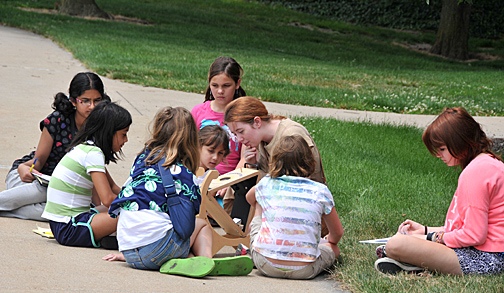The University of Toledo is using its expertise in astronomy to advance science education for the younger generations and encourage young girls’ interest in the field.

Recent UT graduate Marina Kounkel, center, explained how a sunspotter worked during the recent Girls in Science Program.
And in June, 25 girls from Toledo area elementary and middle schools came to UT for the Girls in Science Program designed to encourage young girls to explore their interest in science and math.
The girls who signed up for the free event watched educational programs in Ritter Planetarium, participated in hands-on activities, and toured some of UT’s research facilities. All expenses were paid by a career grant from the National Science Foundation (NSF) awarded to Dr. Rupali Chandar, associate professor of astronomy and creator of the workshop.
“The idea of the workshop is to bring together girls who are interested in math and science, or think they might be interested in math and science, and give them a safe environment to come together and meet other like-minded girls,” Chandar said.
During the event, students made their own solar cells, which were more primitive versions of the technology used to produce solar energy by converting light from the sun into electricity.
The girls also got to ride energy-creating bikes in McMaster Hall and were taught how the global climate is changing and the importance of finding cleaner forms of energy than fossil fuels.
It is important to reach out to girls while in elementary and middle school grades, Chandar said, because this is when they are at a formative age when they start to realize their interests and become more receptive to what their peers are doing.
Girls in Science is held once a semester, and Chandar hopes to find other sources of funding beyond the NSF grant to continue and expand the program to help fix what she called the “leaky pipeline” of girls in science.
“We still have a real problem attracting and maintaining women in science,” Chandar said. “While the numbers have improved over the last couple decades, they’re still pretty bad. When you’re losing representation from half your population, that’s not good for the advancement of science.”
In addition to the Girls in Science Program, Ritter Planetarium puts on shows for children regularly, and many of the schools in the area visit for field trips.